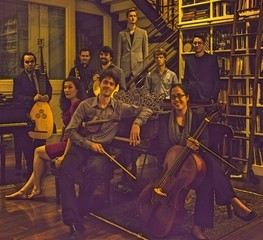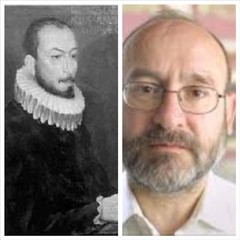|
Back
Constellations In The Library New York
Library, House of the Redeemer, 7 East 95th Street
02/06/2015 -
Re.i.ma.dri.gals:
Claudio Monteverdi: Tempro la cetra – Chiome d’oro
Carlo Gesualdo, Prince of Verona: Le voci sottovetro, 1-4 (Arranged by Salvatore Sciarrino)
Johannes Brahms: Fünf Ophelia Lieder (Arranged by Aribert Reimann)
George Crumb: Madrigals, Book I
Michel Pignolet de Montéclair: La Mort de Didon
Jacob Ashworth (Violin, Conductor), Jessica Petrus (Soprano), Sara Couden (Alto) Stuart Breczinski (English Horn), Hannah Collins (Cello), Lee Dionne (Harpsichord, Piano), Batmyagmar Erdenbat (Viola), Isabel Lepanto Gleicher (Bass Flute), Barbora Kolarova (Violin), Arash Noori (Theorbo), David Perry (Bass Clarinet), Doug Perry (Percussion), Samuel Suggs (Double Bass)

Cantata Profana (© Henry Chen)
Before a single note was plucked, strummed, bowed, sung or blown last night, the marvels of Cantata Profana were visually unnerving for the usual concertgoer.
The venue was the upstairs library of this Upper West Side “retreat house”, a virtual Renaissance book-chamber. Seating barely 100 by my guess, the room is constructed from dark pine paneling, the walls themselves jammed with volumes secular and Christian, not only on all four sides but atop a balustrade surrounding the room. Eight seven-branched candlesticks, a coat of arms, ceilings almost 30 feet high, a small stage...
A massive fireplace on this frosty night kept its guests as warm as they would have been during a Tuscany winter. All that was missing was one of those giant mastiff dogs shown in 16th Century paintings.
The audience, coming from another era and another world, seemed to be all colleagues, and while unfamiliar to me, I imagined them to be Gothic scholars, manuscript illuminators, philomaths, alchemists and apothecaries. Those kind of listeners would no more countenance a cough during the music than brook a Black Plague germ.
Sitting a few inches from the music area, they gazed upon a consort of instruments, which intermingled various millennia. A delicately-painted harpsichord, a grotesque therebo, tubular bells, vibraphone, bass violin and bass clarinet–all giving the illusion that this was either an Elizabethan masque or an avant-garde happening.
Yet this was no either/or situation. The young thriving Cantata Profana was to perform every era except the expected one. The scanty program gave nothing away but the titles to the unfamiliar works, and while this might have seemed a private joke challenge to scholars, it was an unneeded hurdle for us plebeians.
Still, even the most familiar composers had an unfamiliar touch. Yes, we had four madrigals by Prince Gesualdo, the murderous ignoble noble born into a house of sorcerers, his music as scary as his life. But how did Salvatore Sciarrino, the brilliant living Italian composer, find himself associated with such company? Brahms was here, but the five poems based on the words of Hamlet’s Ophelia, arranged by another German composer, are virtually unknown and proved to be epigrammatic at best.
(Though the very bourgeois Brahms simply refused to set Shakespeare’s “Hey non nonny, nonny, hey, nonny”. He turned the nonsense into a ridiculous “Leider, ach leider!”, which was literally “quite unfortunate”).
And who on earth was this multi–christened Michel Pignolet de Montéclair and why was he writing a lament for Dido, when we all knew that Henry Purcell was the winner of any lament competition?
Once the musicians entered, no puzzles were solved, for that would have put these musicians on an earthly plane. Instead, Cantata Profana, the New Haven-based ensemble, produced an unparalleled, expertly arranged, inventive, instructive 75 minutes which did span the centuries.
The eleven artists, with two singers, started in the most authentic way possible, with an instrumental work by Monteverdi, mainly for strings and harpsichord. The only non-ragged Monteverdi is Carl Orff’s abominable orchestration, and these players had none of it. The stops and starts were a bit irregular, but this apparent Monteverdi-sized ensemble played it the way it’s played today in Venice.

C. Gesualdo/S. Sciarrino (© Commons.wikimedia)
Four madrigals by Gesualdo, sung by Sara Couden, a mezzo-soprano with the range of a bel canto soprano, had a different feel, because Salvatore Sciarrino (like so many other composers) had arranged the songs for an orchestra that included winds, a variety of bells and vibraphone, and just enough eccentricity to give what was titled “Voices behind glass” a modern touch.
The conservative color of the instruments was engaging, and Ms. Couden, whose voice was simply part of the instrumentation, gave an enchanting performance.
Alas, I doubt if any composer today has the eccentricity, the mordant, unremitting self-pity of Gesualdo himself. Sciarrino is, yes, an expert on Gesualdo, almost finished a whole opera on his life. But trying to gild this poisoned lily might seem a losing proposition.
Those Brahms songs were written for a very strange combination of string quartet and vocalist , and were sung, within their miniature scope, with great feeling by soprano Sara Couden. After an entrancing Monteverdi duet with Ms. Petrus, she came into her own, and put us on familiar grounds. But after an entrancing Monteverdi duet with Sara Couden, she came into her own, and put us on familiar grounds.
George Crumb needed no gilding, no arranging. The West Virginian, still in hearty spirits, wrote this first book of Madrigals to the great Spanish poetry of Federico Garcia Lorca.
Yet music by George Crumb–for those who can handle it–can delight the soul and light up the sound atmosphere. This was where Ms Petrus came into her own, first with the (now usual) vocalisms going up and down the scale. But in the later moments, she was part of an entrancing trio of double bass, percussion (that is, vibraphone, bells and other unnameable instruments).
George Crumb has no hesitation in telling the percussionist to rub his sticks against the double bass, or to give the double bass tricky hand motions, or to tell the trio to give a whispered, mysterious, phantasmal offering in Crumb’s setting of Lorca’s Los muertos llevan alas de musgo–”The dead wear mossy wings.” This was where Ms. Petrus was not merely part of an ensemble, but where her radiant soprano actually seemed to be created by the instruments, coming into its own, and then, in a “dying fall” ingrained itself to the atmosphere.
The final long work was a replacement for the generically-puzzling Monteverdi Il Combattimento di Tancredi e Clorinda, certainly the composer’s most passionate non-operatic work. Instead, we had a “Dido Lament” by aforesaid Michel Pignolet de Montéclair. Nobody can compete with Monteverdi, but this almost anonymous composer, who lived after the Italian tried his best with a work which included virtuoso violin playing by Cantata Profana leader Jacob Ashworth. To say this was a rarity would be understating the obvious.
But that rarity, like all the works on this so esoteric, so extraordinary program in this antiquated setting offered constellations of inspiration. They were so distant, yet in their music, after so many centuries, still so emotionally personal.
Harry Rolnick
|